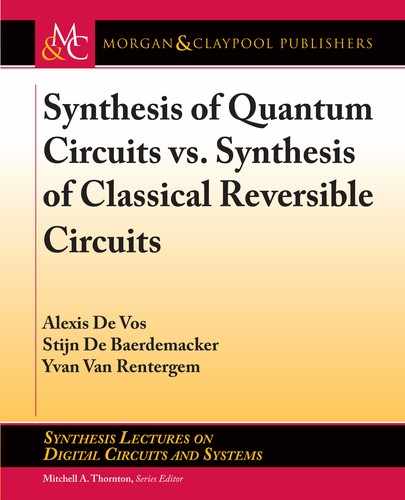
4.2. PRIMAL DECOMPOSITION 69
with ! equal to the cubic root of unity (! D e
i 2=3
D 1=2 C i
p
3=2). Beneath each of the
4n 2 blocks is displayed the number of real parameters of the block. ese numbers sum to
16, i.e., exactly n
2
, the dimensionality of U(n).
Hence, the synthesis problem of an arbitrary U(2
w
) matrix involves, for the given value
of w, the synthesis of the 2
w
1 circuits T
j
. e synthesis of such matrices is not straigthfor-
ward [61]. For T
3
above, the following ad hoc decomposition is helpful:
T
3
D
0
B
B
@
1
1
1=
p
2 1=
p
2
1=
p
2 1=
p
2
1
C
C
A
0
B
B
@
1
1=
p
3
p
2=
p
3
p
2=
p
3 1=
p
3
i
1
C
C
A
0
B
B
@
1
1
1=
p
2 1=
p
2
1=
p
2 1=
p
2
1
C
C
A
:
However, no general-purpose technique is available for an arbitrary n n matrix of the form
(4.2) where j satisfies 2 j n 1.
e repeated application of the ZXZ theorem thus, in principle, allows the implementa-
tion of quantum circuits [61], with the help of 2 2 PHASOR gates and j j Fourier-transform
circuits with 2 j 2
w
. However, compact and elegant in mathematical form, the ZXZ de-
composition is not naturally tailored to qubit-based quantum circuits due to the presence of the
j j Fourier transforms. Indeed, whenever j is not a power of 2, the Fourier transform acts
on a subspace of the total 2
w
-dimensional Hilbert space rather than on a subset of the w qubits.
In the next section, we will demonstrate a more natural synthesis method, with all j exclusively
equal to some 2
a
with 1 a w. It will even turn out that j D 2 suffices. us only the 2 2
Fourier-transform gate, i.e., the HADAMARD gate, will be necessary.
4.2 PRIMAL DECOMPOSITION
Below we will demonstrate the more natural synthesis method, which respects the qubit struc-
ture of the quantum circuit to be synthesized. At each step, the algorithm lowers the matrix size
by a factor of 1/2. us, instead of matrices from the group sequence U(n), U(n 1), U(n 2),
…, we will take matrices from U(n), U(n=2), U(n=4), …. As a result, the method is not appli-
cable for arbitrary n, but only useful for n equal to some power of 2, i.e., for n D 2
w
. But this is
exactly the n value we need for circuit synthesis.
We recall that an arbitrary member of U(2) can be decomposed as two DU(2) matrices
and one XU(2) matrix: see (3.6). We recall that Idel and Wolf [58] proved the generalization
for an arbitrary element U of U(n) with arbitrary n:
U D D
1
XD
2
;

70 4. TOP
where D
1
is an n n diagonal unitary matrix, X is an n n unitary matrix with all line sums
equal to 1, and D
2
is an n n diagonal unitary matrix with upper-left entry equal to 1. See
Section 3.7. Führ and Rzeszotnik [62] proved another generalization for an arbitrary element U
of U(n), however, restricted to even n values:
U D
A 0
0 B
1
2
I C C I C
I C I C C
I 0
0 D
; (4.3)
where A, B, C , and D are matrices from U(n=2) and I is the n=2 n=2 unit matrix. We note
that, in both generalizations, the number of degrees of freedom is the same in the left-hand side
and right-hand side of the equation. In the former case we have
n C .n 1/
2
C .n 1/ D n
2
I
in the latter case we have
2
n
2
2
C
n
2
2
C
n
2
2
D n
2
:
We call (4.3) a block-ZXZ decomposition or bZbXbZ decomposition of U .
If n equals 2
w
, then the decomposition (4.3) allows for a circuit interpretation. e ma-
trices
A
B
and
I
D
are controlled .w 1/-qubit circuits and
1
2
I C C I C
I C I C C
is
an n n matrix with all line sums equal 1. We can write
1
2
I C C I C
I C I C C
D G
I
C
G
1
;
where G is the following n n matrix:
G D
1
p
2
I I
I I
: (4.4)
e (real) matrix G here plays a role similar to the role played by the complex matrix F in
Section 3.6. It has a very simple circuit interpretation: a HADAMARD gate acting on the first qubit:
H
:
e matrix G can be written as a so-called tensor product: G D H ˝ I , where H is the 2 2
Hadamard matrix and I is the n=2 n=2 unit matrix. We have G
1
D G.
We conclude that an arbitrary quantum circuit acting on w qubits can be decomposed
into two HADAMARD gates and four quantum circuits acting on w 1 qubits and controlled by
..................Content has been hidden....................
You can't read the all page of ebook, please click here login for view all page.
